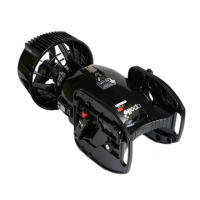
Do you have a question about the Apollo av Series and is the answer not in the manual?
| Brand | Apollo |
|---|---|
| Model | av Series |
| Category | Diving vehicles |
| Language | English |
Describes the patented hands-free riding style using body movement for steering.
Details the smooth speed adjustments via an accelerator lever.
Explains how hands-free riding reduces fatigue and air consumption.
Highlights improved ability to transport items and tow others.
Explains the meaning of DANGER, CAUTION, and WARNING symbols used in the manual.
Covers critical advice on training, diving alone, and awareness of depth/ascent.
Lists important precautions regarding battery, disassembly, moving parts, and water entry.
Details warnings about equipment checks, running out of water, and accessory use.
Labeled diagram showing the parts of the avx scooter.
Lists key technical details like dimensions, weight, speed, and depth rating.
Information on the avx battery, its dimensions, capacity, and weight.
Details about the avx charger specifications and the storage case.
Steps for preparing the scooter and removing the battery housing for charging.
Guides on connecting the charger, charging status indicators, and completion.
Labeled diagram of the av-2 EVOLUTION scooter parts.
Key technical data including dimensions, weight, speed, and depth.
Details on separately purchased, exclusive batteries, and chargers for the av-2 series.
Steps for preparing the av-2 scooter and removing the battery housing.
Instructions for connecting the charger, understanding indicators, and finishing the charge.
Guidance on selecting and handling batteries, including warnings.
Covers battery warranty, self-discharge, storage, and cleaning advice.
Steps for attaching the handle and saddle assembly to the scooter body.
Instructions for setting the battery and battery housing, including seal checks.
Procedure to confirm all locking buckles are securely fastened.
Steps for turning on the main switch and checking the battery indicator.
How to operate the motor and interpret the battery indicator lights.
Turning off the main switch and adjusting the variable pitch propeller.
Instructions for entering the water from shore or elevated areas.
Guidance on how to safely exit the water with the scooter.
Explanation of how the accelerator lever controls speed and pitch.
Details on the built-in safety device that protects the motor from overloading.
Steps for washing the scooter, desalting, and checking/cleaning the propeller assembly.
Instructions for correctly reassembling and securing the propeller unit.
Guidance on maintaining sealing O-rings, using specified grease, and replacement.
Information on body material care, cleaning agents, and proper storage methods.
Step-by-step guide to diagnose why the propeller isn't rotating when the lever is activated.
Further troubleshooting steps involving battery connection, charge, and water leak sensor.
Essential safety advice for diving with the scooter, including equalization and buoyancy.
Explains the accelerator-based, gear-less drive and propeller pitch conversion.
Details on using the saddle, grips, and wing arms for handling and transport.
Information on the extended travel distances possible with the hands-free design.
Guidance on positioning the body for hands-free riding and maintaining balance.
Steps for safely stopping the scooter and landing on the seabed or surface.
Instructions for reducing speed, adjusting buoyancy, and achieving a hovering position.
Methods for taking off from the seabed, managing rotation torque, and avoiding sand disturbance.
Detailed steps for taking off from a stable position on the seabed.
Steps to transition from hovering to riding, including body alignment and buoyancy.
How to ride on the surface and use slow speed settings with proper buoyancy control.
Details on stability, steering, and buoyancy for normal speed riding.
Advice on buoyancy, posture, and avoiding obstacles for high-speed riding.
Explains open, closed, compulsive turns, and using hand brake for steering.
Techniques for drifting and executing sharp hairpin turns using speed and body resistance.
Instructions for riding with two, three, or four+ people in various formations.
How to use wing arms for carrying equipment, balancing weight, and managing resistance.